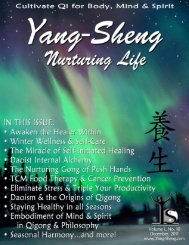Download PDF - Yang-Sheng
Download PDF - Yang-Sheng
Download PDF - Yang-Sheng
You also want an ePaper? Increase the reach of your titles
YUMPU automatically turns print PDFs into web optimized ePapers that Google loves.
assess the feasibility of incorporating a single-session<br />
meditation-training program into the daily activities of<br />
healthy employees of a tertiary-care academic medical<br />
center. The study also assessed the most preferred<br />
duration of meditation and the effect of the meditation<br />
program on perceived stress, anxiety, and overall quality<br />
of life (QOL). POPULATION: Seventeen healthy clinic<br />
employees were recruited for this study.<br />
INTERVENTION: After an initial group instruction<br />
session covering basic information about meditation,<br />
Paced Breathing Meditation (PBM) was taught to the<br />
participants. Participants were instructed to self-practice<br />
meditation with the help of a DVD daily for a total of 4<br />
weeks. The DVD had three different programs of 5, 15,<br />
and 30 minutes with a menu option to choose one of the<br />
programs. OUTCOME MEASURES: (1) Patient diary,<br />
(2) Perceived Stress Scale (PSS), (3) Linear Analogue<br />
Self-Assessment (LASA), (4) Smith Anxiety Scale<br />
(SAS). Primary outcome measures were compared using<br />
the paired t-test. RESULTS: All participants were female;<br />
median age was 48 years (range 33-60 y). The 5-minute<br />
meditation session was practiced by 14 participants a<br />
total of 137 times during the 4-week trial period, the 15minute<br />
session by 16 participants a total of 223 times,<br />
and the 30-minute session by 13 participants 71 times.<br />
The median number of days practiced was 25 (range 10-<br />
28 d); the average total time practiced was 394 minutes<br />
(range 55-850 min). After 4 weeks of practice, the scores<br />
of the following instruments improved significantly from<br />
baseline: PSS (P < .0001), SAS (P = .0005), LASA (P<br />
= .0005). No relationship was noted between the length<br />
of time practiced and improvement of PSS, SAS, and<br />
LASA scores. CONCLUSION: This pilot study<br />
indicates the feasibility of teaching meditation in a single<br />
training session to health care employees. The study<br />
shows that 15 minutes once or twice a day is the most<br />
feasible duration of meditation practice. The study also<br />
provides promising preliminary efficacy data of this<br />
program for improving stress, anxiety, and QOL.<br />
Meditation experience is associated with differences<br />
in default mode network activity and connectivity.<br />
Proc Natl Acad Sci U S A. 2011 Dec 13;108(50):20254-<br />
9. By Brewer JA, Worhunsky PD, Gray JR, Tang YY,<br />
Weber J, Kober H. from Department of Psychiatry, Yale<br />
University School of Medicine, New Haven, CT 06511.<br />
Many philosophical and contemplative traditions<br />
teach that "living in the moment" increases happiness.<br />
However, the default mode of humans appears to be that<br />
of mind-wandering, which correlates with unhappiness,<br />
and with activation in a network of brain areas associated<br />
with self-referential processing. We investigated brain<br />
activity in experienced meditators and matched<br />
meditation-naive controls as they performed several<br />
different meditations (Concentration, Loving-Kindness,<br />
Choice-less Awareness). We found that the main nodes<br />
of the default-mode network (medial prefrontal and<br />
posterior cingulate cortices) were relatively deactivated<br />
in experienced meditators across all meditation types.<br />
Furthermore, functional connectivity analysis revealed<br />
stronger coupling in experienced meditators between the<br />
posterior cingulate, dorsal anterior cingulate, and<br />
dorsolateral prefrontal cortices (regions previously<br />
implicated in self-monitoring and cognitive control),<br />
both at baseline and during meditation. Our findings<br />
demonstrate differences in the default-mode network that<br />
are consistent with decreased mind-wandering. As such,<br />
these provide a unique understanding of possible neural<br />
mechanisms of meditation.<br />
(Compiled by Kevin W Chen)<br />
Kevin Chen, Ph.D., MPH<br />
is an associate professor at<br />
the Center for Integrative<br />
Medicine and Department<br />
of Psychiatry, University<br />
of Maryland School of<br />
Medicine (USA). Dr.<br />
Chen was educated in the<br />
universities of both China<br />
and the United States, and has years of experience and<br />
training in blending eastern and western perspectives,<br />
and in the practice of life-nurturing methods. As a longtime<br />
practitioner of Qigong <strong>Yang</strong> <strong>Sheng</strong>, he is one of the<br />
few scientists in the U.S. to have both hands-on<br />
knowledge of mind-body practice, and an active research<br />
career in mind-body medicine, which is funded through<br />
grants by the National Institutes of Health (NIH) and<br />
various foundations. Dr. Chen devotes his career and life<br />
to the practice of <strong>Yang</strong> <strong>Sheng</strong>, and promotion of selfhealing<br />
and mind-body-spirit integration through the non<br />
-profit organization, World Institute for Self Healing<br />
(WISH) (http://www.wishus.org).<br />
36 <strong>Yang</strong>-<strong>Sheng</strong> (Nurturing Life) Volume 2, Issue No. 1













